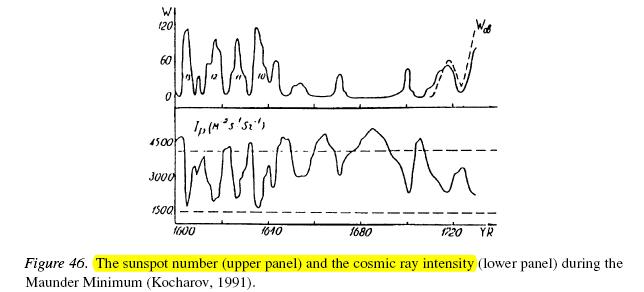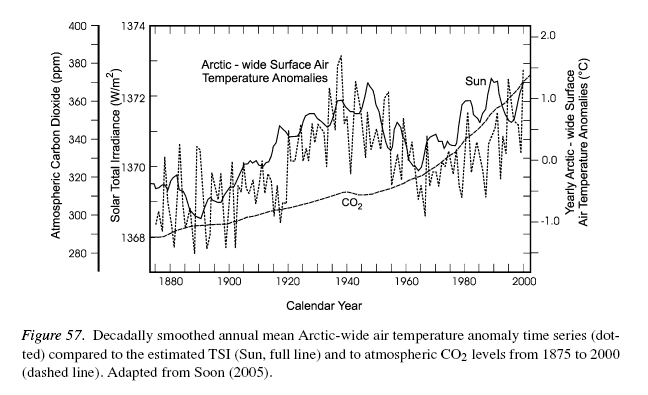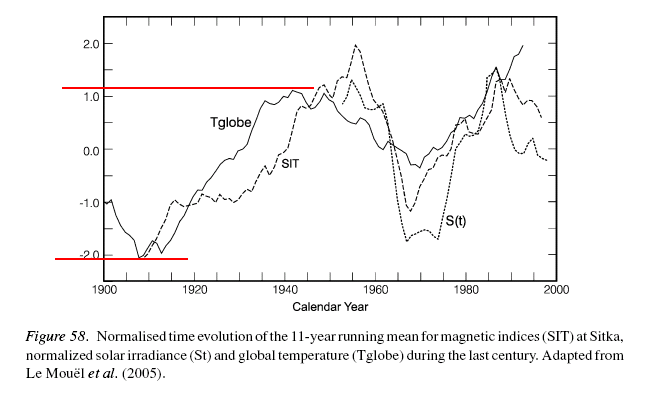Cosmic Ray Imprints in Terrestrial Archives
and their Implications to Climate

|
Cosmic Ray Imprints in Terrestrial Archives and their Implications to Climate
|
 |
Jan VEIZER, Hebrew University Jerusalem, 91904 Israel
some excerpts from Part VII (author: Jan Veizer) of
INTERSTELLAR-TERRESTRIAL RELATIONS: VARIABLE COSMIC
ENVIRONMENTS, THE DYNAMIC HELIOSPHERE, AND THEIR
IMPRINTS ON TERRESTRIAL ARCHIVES AND CLIMATE
K. SCHERER
1,∗, H. FICHTNER1, T. BORRMANN1, J. BEER2, L. DESORGHER3,E. FLU¨ KIGER
3, H.-J. FAHR4, S. E. S. FERREIRA5, U. W. LANGNER5,M. S. POTGIETER
5, B. HEBER6, J. MASARIK7, N. J. SHAVIV8 and J. VEIZER9(full paper here)

...
This “natural” greenhouse effect is overwhelmingly due to water vapour, the principal greenhouse gas, and only to a lesser degree to other greenhouse gases (GHG), such as CO2, CH4 , N2O or CFCs. The global water cycle plays therefore the dominant role, about 60% in the magnitude of the “greenhouse” effect. It also is the major player in the global transfer of energy from the equator to the poles, a redistribution that is responsible for vagaries of regional climates.
...
The “anthropogenic” addition of GHG, principally CO2, since the advent of the industrial revolution, is believed to have enhanced the natural greenhouse effect by ≈2.5 Wm−2 (Ramaswamy et al., 2001). For comparison, satellite data for less than a decade (1995–2002) suggest a decline in the cloud albedo by ≈7% (Kandel and Viollier, 2005; their Figure 3b), consistent with a 2–6 Wm−2 enhancement of the short wave solar energy input into the system (Pall´e et al., 2005; Wild et al.,2005). The current scientific and political dispute boils down ultimately to the following: is the additional energy that is responsible for the centennial temperature^rise of ≈0.6◦C due principally to GHG or is it due to some external factor, such as the Sun? Note that we are not dealing with mutually exclusive scenarios. Climate models would respond in a similar way to the addition of energy from any source and it is only the relative importance of these potential “drivers”, at a variety of time scales, which is the contentious issue. Note also that, compared to the sizes of the global energy fluxes, and their overall uncertainty of the order ±6 Wm−2 , the apparent centennial to annual trends are at the limit of detectability (Kandel and Viollier, 2005). It is therefore not likely that the issue of principal climate driver can be resolved by energy balance considerations. Instead, observations based on past climate trends and their compatibility with the celestial vs GHG records may help to resolve their relative contributions.
...
Considering that the “consensus” view (IPCC, 2001) favours CO
2 as the principal climate driver on most (Ruddiman, 2001), or at least the human, time scales, it is important to ask what is the “sensitivity” of climate to doubling of CO2 from its “preindustrial” value of ≈280 ppm . Direct radiative forcing of 4 Wm−2 , attributed to CO2 doubling, should theoretically increase the global temperature by ≈1.25◦C, short of the predictions by general circulation models (GCMs) of 1.5–4.5 ◦C. Similarly, direct empirical surface measurements show a centennial temperature rise of only ≈0.6 ◦C (IPCC, 2001), of which ≈1/3 is attributed to the observed increase in solar brightness. The “anthropogenic” greenhouse effect, of ≈80–100 ppm CO2, should thus account for ≈0.4 ◦C. An extrapolation of these empirical data to CO2 doubling would therefore suggest that the real climate sensitivity to CO2 is closer to, or below, the minimal model predictions of 1.5 ◦C (Shaviv, 2005), consistent with the direct satellite and balloon observations for the mid-lower troposphere (Sherwood et al., 2005; Mears and Wentz, 2005; Pinker et al., 2005). The amplification of temperatures in GCMs is thus mostly due to the positive feedback of higher atmospheric water vapour concentrations, and the large spread in their predictions reflects essentially the differences in model parameterization of clouds. The attribution of only ≈1/3 of the centennial temperature rise to solar forcing (Mitchell et al., 2001), despite very good correlation, is based on the empirical observation that averaged over the 11-year solar cycle the Total Solar Irradiance (TSI) variability is only 0.08% (1.1 Wm−2 ) (Lean, 2005; Gray et al., 2005), insufficient While the impact of direct solar radiative forcing relative to amplification of TSI by indirect mechanisms is still a subject of debate, the detection/attribution assessments of climate models “suggest that the solar influence on climate is greater than would be anticipated from radiative forcing estimates. This implies that either the radiative forcing is underestimated or there are some processes inadequately represented in those models” (Gray et al., 2005). If so, climate modulation by indirect amplifying mechanisms may play an important role.....

....
A general consensus accepts that the pre-1940’s temperature because of only a slight increase in atmospheric CO2 levels, could not have caused by GHGs, and this warming is thus attributed mostly to increased activity (Mitchell et al., 2001). The subsequent evolution, however, is a bone contention. Solanki et al. (2004) and Usoskin et al. (2006), reconstructing evolution from observational and proxy data, showed that the Sun’s intensity the second half of the 20th century was higher than at any time over the last ≈4000 to 8 000 years (but see Muscheler et al., 2005b vs. Solanki et al., 2005). Their trend and the IPCC temperature trend are almost identical, except for the last 3 decades, when the temperature rise exceeded that of the solar index. Solanki coauthors attributed this to the emergence of the anthropogenic CO2 signal the background of natural variability, while the “consensus” IPCC interpretation attributes even the entire post-1940’s temperature trend mostly to anthropogenic causes, with cooling to 1976 due to emissions of sulphur aerosols and the subsequent warming to GHGs (Mitchell et al., 2001).
For the 1985–2000 (or 2002) interval alone, the impact of such forcings on the
planetary energy balance is claimed to have been +2 to 6 Wm−2 , coincident with a decline of the Bond albedo of ≈7% (Kandel and Viollier, 2005), while for the combined GHG+aerosol it was only+0.6 Wm−2 . For the 2000–2004 period, the somewhat inconclusive data indicate a comparable relative importance. For comparison, the cumulative radiative forcing of all anthropogenic GHGs combined is estimated at ≈2.5 Wm−2 (IPCC, 2001). These observations suggest that celestial phenomena may have been the dominant forcing factor even during the most recent past.

....
A change in cloudiness of only a few percent could potentially alter the planetary energy balance by as much as the proposed anthropogenic GHG effect (2.5 Wm−2 ).
excerpts by meteoLCD, 09Feb07